- Home
- Wendell Berry
Bringing It to the Table: On Farming and Food Page 14
Bringing It to the Table: On Farming and Food Read online
Page 14
Charlie’s second reason for using horses in the woods, almost as important as the first, is that he likes the woods, and horses leave the woods in better condition than a skidder. A team and a logging arch require a much narrower roadway than a skidder; unlike a skidder, they don’t bark trees; and they leave their skidding trails far less deeply rutted. “The horse,” Charlie says, “will always be the answer to good logging in a woods.”
A third attractive feature of the horse economy in the woods is that the horse logger both earns and spends his money in the local community, whereas the mechanical skidder siphons money away from the community and into the hands of large corporate suppliers. Moreover, the horse logger’s kinder treatment of the woods will, in the long run, yield an economic benefit.
And, finally, horses work far more cheaply and cost far less than a skidder, thus requiring fewer trees to be cut per acre, and so permitting the horse logger to be more selective and conservative.
(Another issue involved in the use of horses for work is that of energy efficiency. Legs are more efficient than wheels over rough ground—something that will quickly be apparent to you if you try riding a bicycle over a plowed field.)
Well ahead of the logging crews, Charlie goes into the woods to mark the trees that are to be cut. Except when he is working for a “developer” who is going to clear the land, Charlie never buys or marks trees with the idea of taking every one that is marketable. His purpose is to select a number of trees, often those that need cutting because they are diseased or damaged or otherwise inferior, which will provide a reasonable income to landowner and logger alike, without destroying the wood-making capacity of the forest. The point can best be understood by considering the difference between a year’s growth added to a tree fourteen inches in diameter and that added to a tree four inches in diameter. Clear-cutting or any other kind of cutting that removes all the trees of any appreciable size radically reduces the wood-making capacity of the forest. After such a cutting, in Charlie’s part of the country, it will be sixty to a hundred years before another cutting can be made. Of a clear-cut woodland that adjoined one of his own tracts, Charlie said, “In fifty years there still won’t be a decent log in it.”
Charlie does not believe that such practices are good for the forest or the people—or, ultimately, for the timber business. He stated his interest forthrightly in economic terms, but his is the right kind of economics: “I hope maybe there’ll be trees here for my son to cut in ten or twenty years.” If you don’t overdo the cutting, he says, a woodland can yield a cash crop every ten to fifteen years. We looked at one tract of twenty acres on which Charlie had marked about 160 trees and written the owner a check for $23,000. Charlie described this as “a young piece of timber,” and he said that it “definitely” could be logged again in ten years—at which time he could both take more and leave more good trees than he will take and leave at this cutting.
Owners of wooded land should consider carefully the economics of this twenty-acre tract. If it is selectively and carefully logged every ten years, as Charlie says it can be, then every acre will earn $1,150 every ten years, or $115 per year. And this comes to the landowner without expense or effort. (These particular figures, of course, apply only to this particular woodlot. Some tracts might be more productive, others less.)
We looked at marked woodlands, at woodlands presently being logged, and finally, at the end of the second day of our visit, at a woodland that one of Charlie’s crews had logged three years ago. The last, a stand predominantly of hard and soft maples, provided convincing evidence of the good sense of Charlie’s kind of forestry. Very few of the remaining trees had been damaged by trees felled during the logging. I saw not a single tree that had been barked by a skidded log. The skid trails had completely healed over; there was no sign of erosion. And, most striking, the woodland was still ecologically intact. It was still a diverse, uneven-aged stand of trees, many of which were over sixteen inches in diameter. We made a photograph of three trees, standing fairly close together, which varied in diameter from seventeen to twenty-one inches. After logging, the forest is still a forest, and it will go on making wood virtually without interruption or diminishment. It seems perfectly reasonable to think that, if several generations of owners were so inclined, this sort of forestry could eventually result in an “old growth” forest that would have produced a steady income for two hundred years.
I was impressed by a good many things during my visit with Charlie Fisher, but what impressed me most is the way that Charlie’s kind of logging achieves a complex fairness or justice to the several interests that are involved: the woods, the landowner, the timber company, the woods crews and their horses.
Charlie buys standing trees, and he marks every tree he buys. Within a fairly narrow margin of error, Charlie knows what he is buying, and the landowner knows what he is getting paid for. When Charlie goes in to mark the trees, he is thinking not just about what he will take, but also about what he will leave. He sees the forest as it is, and he sees the forest as it will be when the logging job is finished. I think he sees it too as it will be in ten or fifteen or twenty years, when David or another logger will return to it. By this long-term care, he serves the forest and the landowner as well as himself. As he marks the trees he is thinking also of the logging crew that will soon be there. He marks each tree that is to be cut with a slash of red paint. Sometimes, where he has seen a leaning deadfall or a dead limb or a flaw in the trunk, he paints an arrow above the slash, and this means “Look up!” The horses, like the men, are carefully borne in mind. Everywhere, the aim is to do the work in the best and the safest way.
Moreover, these are not competing interests, but seem rather to merge into one another. Thus one of Charlie’s economic standards—“I hope maybe there’ll be trees here for my son to cut in ten or twenty years”—becomes, in application, an ecological standard. And the ecological standard becomes, again, an economic standard as it proves to be good for business.
Most landowners, Charlie says, care how their woodlands are logged. Though they may need the income from their trees, they don’t want to sacrifice the health or beauty of their woods in order to get it. Charlie’s way of logging recommends itself to such people; he does not need to advertise. As we were driving away from his house on the morning of our second day, one of the neighbors waved us to a stop. This man makes his living selling firewood, and he had learned of two people who wanted their woodlands logged by a horse logger. That is the way business comes to him, Charlie said. Like other horse loggers, he has all the work he can do, and more. It has been ten years since he has had to hunt for woodlots to log. He said, “Everybody else has buyers out running the roads, looking for timber.” But he can’t buy all that he is offered.
I don’t know that I have ever met a man with more enthusiasms than Charlie Fisher. I have mentioned already his abounding interest in his family, in forestry, and in working and pulling horses, but I have neglected to say that he is also a coon hunter. This seems to me a most revealing detail. Here is a man who makes his living by walking the woods all day, and who then entertains himself by walking the woods at night.
He told me that he had a list of several things he had planned to do when he retired, but that now, at sixty-six, he is busier than ever.
“Well,” I said, “you seem to be enjoying it.”
“Oh,” he said, “I love it!”
A Talent for Necessity
(1980)
IN THE DAYS when the Southdown ram was king of the sheep pastures and the show ring, Henry Besuden of Vinewood Farm in Clark County, Kentucky, was perhaps the premier breeder and showman of County, Kentucky, was perhaps the premier breeder and showman of Southdown sheep in the United States. The list of his winnings at major shows would be too long to put down here, but the character of his achievement can be indicated by his success in showing carload lots of fat lambs in the Chicago International Livestock Exposition. Starting in 1946, he sent eighteen
carloads to the International, and won the competition twelve times. “I had ’em fat,” he says, remembering. “I had ’em good.” Such was the esteem and demand for his stock among fellow breeders that in 1954 he sold a yearling ram for $1,200, then a record price for a Southdown.
One would imagine that such accomplishments must have rested on the very best of Bluegrass farmland. But the truth, nearly opposite to that, is much more interesting. “If I’d inherited good land,” Henry Besuden says, “I’d probably have been just another Bluegrass farmer.”
What he inherited, in fact, was 632 acres of rolling land, fairly steep in places, thin soiled even originally, and by the time he got it, worn-out, “corned to death.” His grandfather would rent the land out to corn, two hundred acres at a time, and not even get up to see where it would be planted—even though “it was understood to be the rule that renters ruined the land.” By the time Henry Besuden was eight years old both his mother and father were dead, and the land was farmed by tenants under the trusteeship of a Cincinnati bank. When the farm came to him in 1927, it was heavily encumbered by debt and covered with gullies, some of which were deep enough to hide a standing man.
And so Mr. Besuden began his life as a farmer with the odds against him. But his predicament became his education and, finally, his triumph. “I was lucky,” he told Grant Cannon of The Farm Quarterly in 1951. “I found that I had some talent for doing the things I had to do. I had to improve the farm or starve to death; and I had to go into the sheep business because sheep were the only animals that could have lived off the farm.”
Now seventy-six years old and not in the best of health, Mr. Besuden has not owned a sheep for several years, but he speaks of them with exact remembrance and exacting intelligence; he is one of the best talkers I have had the luck to listen to. How did he get started with sheep? “I was told they’d eat weeds and briars,” he says, looking sideways through pipesmoke to see if I get the connection, for the connection between sheep and land is the critical one for him. The history of his sheep and the history of his farm are one history, and it is his own.
Having only talent and necessity—and unusual energy and determination—Mr. Besuden set about the restoration of his ravaged fields. There was no Soil Conservation Service then, but a young man in his predicament was bound to get plenty of advice. To check erosion he first tried building rock dams across the gullies. That wasn’t satisfactory; the dams did catch some dirt, but then the fields were marred by half-buried rock walls that interfered with work. He tried huge windrows of weeds and brush to the same purpose, but that was not satisfactory either.
Some of the worst gullies he eventually had to fill with a bulldozer. But his main erosion-stopping tool turned out, strangely enough, to be the plow, the tool that in the wrong hands had nearly ruined the farm, in the right hands healed it. Starting at the edge of a gulley he would run a backfurrow up one side and down the other, continuing to plow until he had completed a sizable land. And then he would start at the gulley again, turning the furrows inward as before. He repeated this process until what had been a ditch had become a saucer, so that the runoff, rather than concentrating its force in an abrasive torrent, would be shallowly dispersed over as wide an area as possible. This, as he knew, had been the method of the renters to prepare the gullied land for yet another crop of corn. For them, it had been a temporary remedy; he made it a permanent one.
Nowadays Kentucky fescue 31 would be the grass to sow on such places, but fescue was not available then. Mr. Besuden used small grains, timothy, sweet clover, Korean lespedeza. He used mulches, and he did not overlook the usefulness of what he knew for certain would grow on his land—weeds: “Briars are a good thing for a little hollow.” In places he planted thickets of black locust—a native leguminous tree that would serve four purposes: hold the land, encourage grass to grow, provide shade for livestock, and produce posts. But his highest praise is given to the sweet clover which he calls “the best land builder I’ve ever run into. It’ll open up clay, and throw a lot of nitrogen into the ground.” The grass would come then, and the real healing would start.
Once the land was in grass, his policy generally was to leave it in grass. Only the best-laying, least vulnerable land was broken for tobacco, the region’s major money crop then as now. Even today, I noticed, he sees that his fields are plowed very conservatively. The plowlands are small and carefully placed, leaving out thin places and waterways.
The basic work of restoration continued for twenty-three years. By 1950 the scars were grassed over, and the land was supporting one of the great Southdown flocks of the time. But it was not healed. What was there is gone, and Henry Besuden knows that it will be a long time building back. “’Tain’t in good shape, yet,” he told an interviewer in 1978.
And so if Mr. Besuden built a reputation as one of the best of livestock showmen, the focus of his interest was nevertheless not the show ring but the farm. It would be true, it seems, to say that he became a master sheepman and shepherd as one of the ways of becoming a master farmer. For this reason, his standards of quality were never frivolous or freakish, as show-ring standards have sometimes been accused of being, but insistently practical. He never forgot that the purpose of a sheep is to produce a living for the farmer and to put good meat on the table: “When they asked me, ‘What do you consider a perfect lamb?’ I said, ‘One a farmer can make money on!’ The foundation has to be the commercial flock.” And he wrote in praise of the Southdown ram that “he paid his rent.”
But it was perhaps even more characteristic of him to write in 1945 that “one very important thing is that sheep are land builders,” and to plead for their continued inclusion in farm livestock programs. He had seen the handwriting on the wall: the new emphasis on row cropping and “production” which in the years after World War II would radically alter the balance of crops and animals on farms, and which, as he feared, would help to destroy the sheep business in his own state. (In 1947, Mr. Besuden’s county of Clark had twenty-four breeding flocks of Southdowns, and 30,000 head of grade ewes. That is more than remain now in the whole state of Kentucky.) What he called for instead—and events are rapidly proving him right—was “a long-time program of land building” by which he meant a way of farming based on grass and forage crops, which would build up and maintain reserves of fertility. And in that kind of farming, he was prepared to insist, because he knew, sheep would have an important place.
“I think,” he wrote in his series of columns, “Sheep Sense,” published in The Sheepman in 1945 and 1946, “the fertilizing effect of sheep on the farm has never received the attention it deserves. As one who has had to farm poor land where the least amount of fertilizer shows up plainly, I have noticed that on land often thought too poor for cattle the sheep do well and in time benefit the crops and grass to such an extent that other stock can then be carried. I have seldom seen sheep bed down for the night on anything but high land, and their droppings are evenly scattered on the pasture while grazing, so that no vegetation is killed.”
What he wanted was “a way of farming compatible with nature”; this was the constant theme of his work, and he followed it faithfully, both in his pleasure in the lives and events of nature and in his practical solutions to the problems of farming and soil husbandry. He was never too busy to appreciate, and to praise, the spiritual by-products, as he called them, of farm life. Nor was he too busy to attend to the smallest needs of his land. At one time, for example, he built “two small houses on skids,” each of which would hold twenty-five bales of hay. These could be pulled to places where the soil was thin, where the hay would be fed out, and then moved on to other such places. (In the spring they could be used to raise chickens.)
“It’s good to have Nature working for you,” he says. “She works for a minimum wage.” But in reading his “Sheep Sense” columns, one realizes that he not only did not separate the spiritual from the practical, but insisted that they cannot be separated: “This thing of soil c
onservation involves more than laying out a few terraces and diversion ditches and sowing to grass and legumes, it also involves the heart of the man managing the land. If he loves his soil he will save it.” Once, he says, he thought of numbering his fields, but decided against it—“That didn’t seem fair to them”—for each has its own character and potential.
As a rule, he would have 400 head of ewes in two flocks—a flock of registered Southdowns and a flock of “Western” commercial ewes. After lambing, he would be running something in the neighborhood of 1,000 head. To handle so many sheep on a diversified farm required a great deal of care, and Mr. Besuden’s system of management, worked out with thorough understanding and attention to detail, is worth the interest and reflection of any raiser of livestock.
It was a system intended, first of all, to get the maximum use of forage. This rested on what he understands to be a sound principle of livestock farming and soil conservation, but it was forced upon him by the poor quality of his land. He had to keep row cropping to a minimum, and if that meant buying grain, then he would buy it. But he did not buy much. He usually fed, he told me, one pound of corn per ewe per day for sixty days. But in “Sheep Sense” for December 1945, he wrote: “One-half pound grain with three pounds legume hay should do the job, starting with the hay and adding the grain later.” He creep-fed his early lambs, but took them off grain as soon as pasture was available. In “Sheep Sense,” March 1946, he stated flatly that “creep-feeding after good grass arrives does not pay.”

 The Selected Poems of Wendell Berry
The Selected Poems of Wendell Berry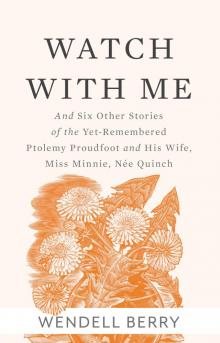 Watch With Me
Watch With Me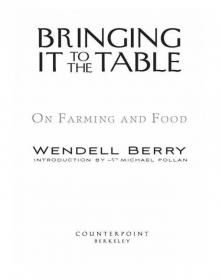 Bringing It to the Table: On Farming and Food
Bringing It to the Table: On Farming and Food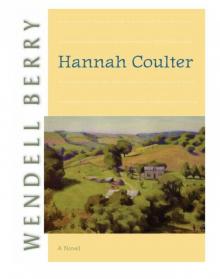 Hannah Coulter
Hannah Coulter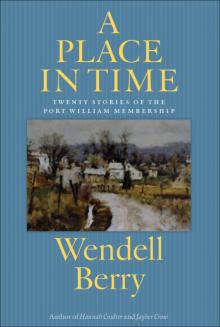 A Place in Time: Twenty Stories of the Port William Membership
A Place in Time: Twenty Stories of the Port William Membership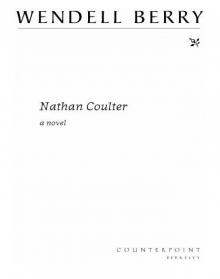 Nathan Coulter
Nathan Coulter Why I Am Not Going to Buy a Computer
Why I Am Not Going to Buy a Computer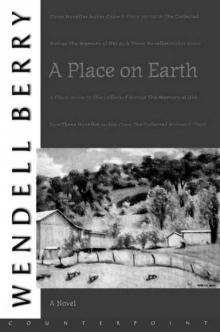 A Place on Earth
A Place on Earth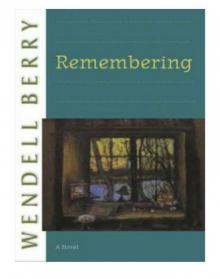 Remembering
Remembering New Collected Poems
New Collected Poems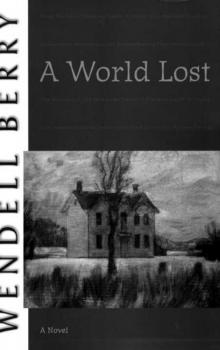 A World Lost
A World Lost Wendell Berry
Wendell Berry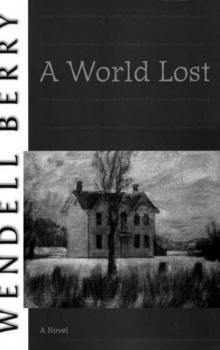 A World Lost: A Novel (Port William)
A World Lost: A Novel (Port William)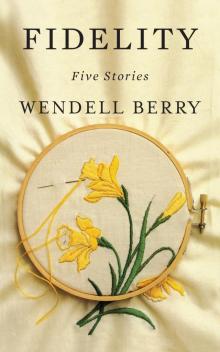 Fidelity
Fidelity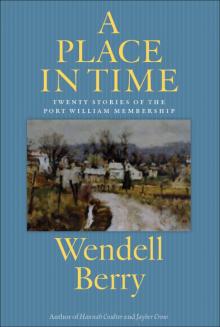 A Place in Time
A Place in Time